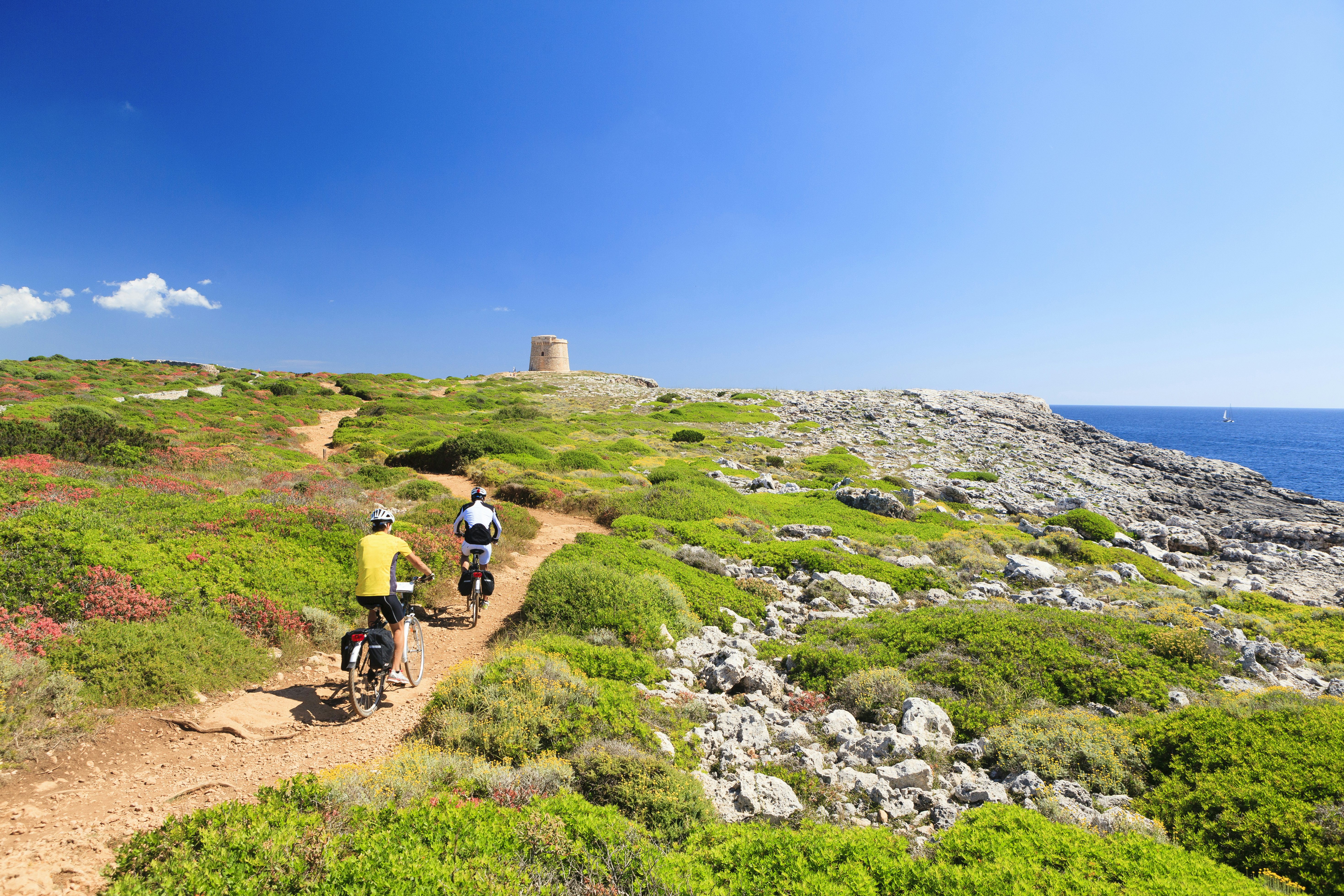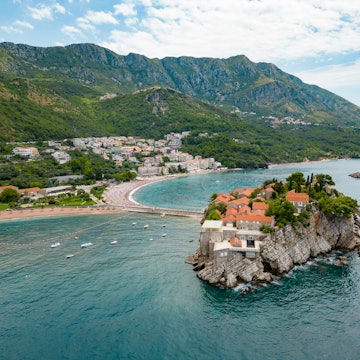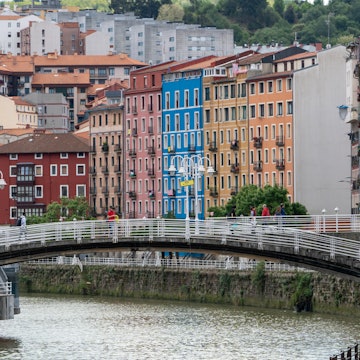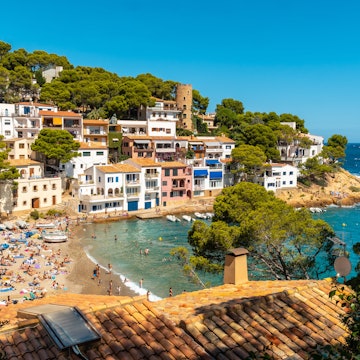
Discovering the off-season beauty of Spain’s Balearic Islands

Jun 24, 2022 • 8 min read

Ibiza is full of moments of zen, especially in the off season © Daniel Garrido/ Getty
Beyond sun-washed summers and seductive Mediterranean beaches, each month brings its own beauty in Spain’s irresistible Balearic Islands, which reveal a deliciously quieter side outside their peak-tourism months (July and August). Spring and autumn mean outstanding birdwatching, color-changing landscapes and peaceful hikes between lonely lighthouses and honey-dusted villages, while winter welcomes a sea of almond blossoms. Year-round, you can sip crisp island wines, feast on fresh seafood, wander around ancient cities, dive into cutting-edge art galleries and much more.
In recent years, the islands have been pushing forward long-term plans to transform tourism here into a more sustainable, less-seasonal industry. Back in 2016, the Balearics became Spain’s second region to introduce a sustainable-tourism tax (ITS; currently up to €4 per night). This has been channeled into (so far) 46 local conservation projects, from restoring remote mountain lodges to protecting the Posidonia seagrass. In early 2022, the Balearics announced its aim to become the world’s first ‘circular destination’, requiring all tourism businesses to develop ways of protecting both the environment and workers’ rights.
As we head into high-season in the Balearic Islands, here are some of the best reasons to consider an off-season trip to enjoy the destination even more.
Historical hiking routes
From cliff-clinging coastal trails to paths through whispering olive groves, the gorgeously varied Balearics are a wonderland for hikers and many routes have intriguing historical links. The best months to head out are March to May, September and October.
Mallorca’s long-distance Ruta de Pedra en Sec (GR221) plunges into the wild, Unesco-protected Serra de Tramuntana along restored medieval stone paths, making for thrilling day walks, too. Stretching 91.7km between Port d’Andratx and Port de Pollença, the trail combines knockout views, arty villages and mountainous landscapes, with accommodation in fuss-free refugis (mountain lodges) and small rural hotels. It currently has an additional 80.3km of signposted branch routes, with another 128km still under development.

In mellow Menorca, the ancient Camí de Cavalls (GR223), with its roots in the 14th century, has been restored as a 185km hiking-and-cycling loop around the island’s coastline, dropping into turquoise bays and twinkling wetlands. Over in Ibiza, take in the unbelievably beautiful shores as you hike between centuries-old watchtowers, such as the southeast’s 16th-century Torre de Ses Portes. And go-slow Formentera has around 30 official Rutes Verdes past disused salt flats, white-walled villages, fortified churches and dreamy blonde-sand beaches.
Why the Azores are Europe's secret islands of adventure
Retreat to a responsible rural hideaway
Blissfully hidden-away agroturismes are a Balearic specialty, usually involving an ancient farmhouse reimagined as an intimate, environment-focused hotel (many powered by renewable energy), where you can enjoy organic-rooted meals and escape into natural surroundings. Some agroturismes produce olive oil, honey and/or vegetables; others combine wine-making with guest-hosting duties. And there are options for all budgets, from northern Menorca’s remote Agroturisme Son Vives, which makes artisanal cheeses and breeds Menorcan horses, to luxe Can Lluc, a pioneering Ibizan oasis built from a 300-year-old, solar-powered farmhouse.
Taste (a few) Balearic wines
Influenced by the salt-tanged Mediterranean, the Balearics’ wine-making heritage spins back to Roman times. With two protected Denominaciones de Origen (DOs), Mallorca leads the way in Balearic drops, though wine-making on all four islands is on the up. The focus is typically on distinctive local grapes, such as monastrell and malvasía, in many cases recovered from the brink of extinction and harvested by hand, and vineyards are often organic-fired family-owned businesses.

Get started with Ibiza’s organic Can Rich (which also makes olive oil), Menorca’s Binifadet (busy reviving autochthonous grapes), Formentera’s Terramoll (also organic-accredited) and Mallorca’s Bodega Can Majoral and Celler Tianna Negre (both pioneers in organic vines). September, when the wine harvest is in full swing, is a wonderful time to visit, and several towns celebrate autumn wine festivals, including Binissalem (Mallorca) and Sant Mateu d’Aubarca (Ibiza).
Why São Miguel is the perfect island for discovering the Azores
Enjoy a culture-loaded city break
The archipelago’s three cities – Palma de Mallorca, Ibiza Town and Maó (Mahón) – make fabulous urban escapes at any time, blending a lively buzz, intriguing historical cores, tempting art galleries, chic boutiques and Balearic gastronomy. Recent years have seen a wave of original boutique hotels arrive, particularly in Palma. A weekend-escape taster here might take in the Gothic beauty of La Seu (in which Antoni Gaudí and Miquel Barceló later had a hand), the Balearics’ greatest contemporary art collection at Es Baluard, the major Fundació Pilar i Joan Miró and exploring creative seaside Santa Catalina.
With its fresh-produce market, British-influenced old town and clutch of museums (including the 2021-launched Hauser & Wirth Menorca gallery), Maó offers a low-key break with a historical edge. And Ibiza Town’s Unesco-listed Dalt Vila takes on a whole new light when you wander around its mansion-filled streets alone; you’ll find a local, off-season scene in the newer part of town.
5 spectacular road trips around Spain
Explore the Balearics’ sole national park
A string of 19 rugged, uninhabited islets off southern Mallorca, the strictly protected 100-sq-km Parc Nacional Marítim-Terrestre de l’Arxipèlag de Cabrera is the only national park in the Balearics, declared in 1991. Ten types of lizards mingle with a wealth of bird species (Eleonora’s falcons, ospreys, Balearic shearwaters) and over 160 marine plants, and swimming, hiking and birdwatching here are a joy. Visitors are welcome on Cabrera island only, with daily numbers capped at 200. Access is by boat trip from Colònia de Sant Jordi from Easter to October; with advance planning, you can stay overnight at the park’s 12-person refugi (refuge).

Savor the islands’ gastronomy
Balearic cuisine is rooted in a slow-food ethos that celebrates traditional recipes, local producers and the freshest regional ingredients. It’s a world of sugar-dusted ensaïmades, paprika-spiced sobrassada, steaming seafood stews, smokey Mahón cheese, perfectly cooked arrossos (rice dishes) and just-grilled fish, and there’s plenty of creative innovation, too. Start with the local market, whether that means a few village farmers’ stalls or Palma’s 1950s Mercat de l’Olivar, with its buzzy tapas bars. Away from the resort areas, plenty of restaurants stay open year-round, particularly in larger cities and towns with a reliable local clientele.
La Tomatina: a guide to Spain's messiest festival
Dive into Balearic history
Inhabited over the centuries by Phoenicians, Romans and Moors, each island has its own historical riches. Ibiza Town’s mesmerizing Dalt Vila is one of Europe’s oldest settlements, founded by the Phoenicians in 654 BCE; nearby Sa Caleta (with a brand-new museum is in the works) is where the Phoenicians first arrived. Also key to the Ibiza/Formentera puzzle are the glittering salt flats, in use since the Phoenician era.
Over in Menorca and Mallorca, mysterious Talayotic monuments turn heads: these Bronze Age creations (burial mounds, worship sites) exist only here. Elsewhere, you can follow in the footsteps of George Sand and Frédéric Chopin (who once lived at Mallorca’s Cartoixa de Valldemossa), jump on the 1912 narrow-gauge Palma–Sóller train, roam around fortified churches on hushed village squares or soak up Menorca’s gold-hued former capital Ciutadella – and that’s only the beginning.
I walked the Portuguese Way of the Camino de Santiago. Here's what it was like
Take the plunge
You don’t need a 30-degree summer day for those delicious pebble coves and silken white-sand beaches. Some brave souls swim year-round, and most beach-lovers jump in from April or May; September, when the sea has warmed up, is blissful. Aigües Blanques (Ibiza), Cala Pregonda (Menorca) and Es Caló (Formentera) are a few of our favourite offbeat spots for a dip, along with Platja des Coll Baix and the quiet strands north of Cala Ratjada in Mallorca.
The best dishes in Spain, and where to try them

Spot the Unesco-listed posidonia seagrass
The rippling Posidonia oceánica (Neptune grass) meadows that carpet the Mediterranean seabed are the big secret behind the Balearics’ ultra-clear, electric-blue waters. This 650-sq-km, oxygen-producing underwater forest defends coastlines against erosion and storms, and is fiercely protected by the 2017-launched Save Posidonia project. The best place to catch a glimpse is the shallow sea between Ibiza and Formentera, at the heart of the bird-rich Unesco-protected Parc Natural de Ses Salines, on a snorkeling or diving trip with Scuba Ibiza.
Discover Spain's unsung food capitals: 11 culinary cities worth the trip
Soak up the winter almond blossom
Spain is one of the world’s top almond-growing countries, and the islands burst into rosy-pink and creamy-white bloom every January/February, with millions of almond trees flowering. The most rewarding pockets are near Santa Agnés de Corona in northern Ibiza and across Mallorca’s interior, especially around pretty Serra de Tramuntana villages such as Valldemossa, Deià and Sóller.
Trail magic happens all the time on Spain's best hikes
Discover a world of local crafts
The Balearic Islands have a long tradition of artisanal crafts, which you’ll spot in everything from palm-woven baskets and beautifully hand-painted ceramics to golden olive oils, tangy salts, herb-infused liqueurs and the important leather-shoe industry (inherited from Moorish times). Local markets are great places to pick up Balearic crafts, and many artisans have now thrown open their studio doors for in-depth tours and workshops. In Ibiza and Formentera, the craft-influenced adlib fashion scene puts on a show at long-established hippie markets including Sant Carles’ year-round Las Dalias, founded in the 1980s.

How to travel responsibly in the Balearic Islands
Mallorca, Menorca and Ibiza have good ferry connections to mainland Spain, offering a greener alternative to flying into the Balearics.
Check out Illes Sostenibles for local projects funded by the region’s tourism tax.
Beach clean-ups are among the positive-impact projects that visitors can get involved in.
Seek out farmers’ markets, and restaurants that prioritize fresh, local (Km0, or zero kilometers traveled) ingredients.
Directly support local tourism initiatives by joining city walking tours, expert-led food jaunts, guided hikes, and so on.
Travel on local buses, avoid single-use items and explore on foot, by bike or on horseback.
The Balearics’ Posidonia is threatened by uncontrolled (and illegal) anchoring and pollution; find out more.
Look for accommodation with a genuine commitment to sustainability, and bear in mind that tourist apartments are driving up rents for local residents.
Isabella Noble travelled to the Balearic Islands with support from the Agència de Estratègia Turística de las Illes Balears (AETIB) and LOTUS. Lonely Planet contributors do not accept freebies in exchange for positive coverage.















